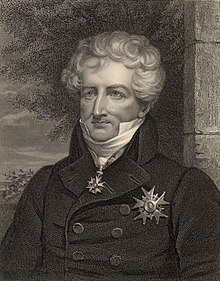Grand Commander (Order)
The term Grand Commander (also Grand Officer or Knight Commander ) referred to in the faleristics the second highest level of which is divided into five levels of knights or Merit .
development
The model for the division of orders of merit into five levels (knight - officer - commander - grand officer - grand cross) is the system that was first introduced in France in 1802 by Napoléon Bonaparte at the foundation of the Legion of Honor (Légion d'honneur) . With the establishment of numerous other orders of merit in the 19th and 20th centuries, this pattern was often adopted and thus achieved worldwide distribution. Orders of merit with three levels (knight - commander - grand cross) have existed since the middle of the 18th century. B. the Hungarian Order of St. Stephen .
Position within the order hierarchy
- Grand Cross (Fig. 5, see below)
- Grand Commander (also "Grand Officer Cross ", "Grand Officer", " Knight Commander ", "Commander 1st Class") (Fig. 4)
- Komtur (also "Komturkreuz", "Kommandeur", "Commander", "Komtur 2nd class") (Fig. 3)
- Officer (also " Officer's Cross ") (Fig. 2)
- Knight (also " Knight's Cross ") (Fig. 1)
Carrying method
Traditionally, the Grand Officer's Cross or Grand Commander's Cross of an Order of Merit is worn on a ribbon around the neck ( neck medal ), with the insignia hanging in the middle of the chest.
This includes a breast star, which in many orders resembles the breast star of the Grand Cross (see fourth illustration in the picture on the right).
Examples

The level of Grand Commander, Grand Officer or Knight Commander existed or exists in the following state orders:
- Askanian house order of Albrecht the Bear
- Grand Ducal Mecklenburg Order of the Griffin
- Order of the British Empire
- Franz Joseph Order
- Military Order of Merit (Bulgaria)
- Order of St. George (Bavaria)
- Guadalupe Order
- Order of Leopold (Belgium)
- Dannebrogorden (Denmark)
- North Star Order (Sweden)
- Military Order of Savoy
- Order of St. Charles (Monaco)
- Order of the Oak Crown (Luxembourg)
- Order of the Dutch Lion (Netherlands)
- Order of Orange-Nassau (Netherlands)
- Order of the Crown of Italy
- Order of Merit of the Italian Republic
- Star of Brabant (Grand Duchy of Hesse)
- Star of Romania
- Order of Merit of the Crown of Hawaii
- Order of Bernardo O'Higgins (Chile)
